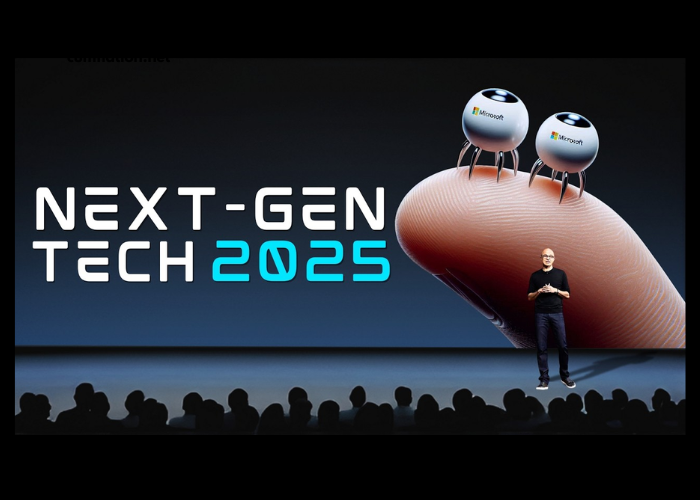
As the world races toward innovation, 2025 promises to be a year where several emerging technologies will significantly reshape industries, economies, and everyday life. From artificial intelligence (AI) to sustainable energy solutions, these technologies are poised to revolutionize how we live and work. In this article, we will explore some of the most promising technologies that are expected to take center stage in 2025.
1. Artificial Intelligence (AI) and Machine Learning (ML)
AI-Powered Automation
Artificial Intelligence continues to dominate the technology landscape, and its capabilities are only set to grow in 2025. Machine learning, a subset of AI, allows systems to learn and adapt from experience, making predictions and decisions without human intervention. This technology is expected to become even more integrated into various sectors, including healthcare, finance, and customer service.
In 2025, AI is expected to reach new levels of sophistication. The automation of repetitive tasks in industries such as manufacturing and logistics will enhance productivity and reduce costs. Additionally, AI’s role in improving personalized experiences in areas like marketing and e-commerce will transform customer interactions and increase revenue opportunities.
Ethical AI Development
As AI continues to evolve, there is a growing emphasis on ethical AI development. In 2025, organizations will be more focused on ensuring that AI systems are transparent, unbiased, and accountable. This could lead to the development of AI frameworks that adhere to strict ethical guidelines, which will, in turn, build public trust in these systems.
2. 5G and Beyond
The Promise of 5G
The rollout of 5G networks has already begun, but by 2025, the full potential of this technology will be realized. 5G promises faster speeds, lower latency, and more reliable connections, transforming how we connect with each other and the world around us. For industries such as healthcare, autonomous vehicles, and smart cities, 5G will enable faster data transfer and improved real-time communication.
6G and Future Connectivity
Beyond 5G, research into 6G is already underway, with expectations for 6G technology to be realized in the early 2030s. However, by 2025, some preliminary advancements in 6G will begin to emerge, with increased focus on ultra-low latency and seamless connectivity. This will allow the integration of a wide range of Internet of Things (IoT) devices, further enhancing the smart technology ecosystem.
3. Quantum Computing
A New Era in Computing Power
Quantum computing is one of the most exciting and disruptive technologies on the horizon. Unlike classical computers, which use bits to process information, quantum computers use qubits. This enables them to perform complex calculations much faster than current computers can.
In 2025, quantum computing is expected to reach new levels of maturity. While fully scalable quantum computers might still be in development, by 2025, advancements in quantum algorithms and hardware could solve problems that were previously thought to be unsolvable. This includes breakthroughs in fields such as cryptography, material science, and drug development.
Impact on Cryptography and Security
One of the primary applications of quantum computing is in cryptography. Quantum computers have the potential to break traditional encryption methods, which would have significant implications for data security. As a result, there will be a strong focus on developing quantum-resistant encryption protocols to protect sensitive data.
4. Blockchain and Decentralized Finance (DeFi)
Blockchain Beyond Cryptocurrency
Blockchain technology, which initially gained popularity through cryptocurrencies like Bitcoin, is now being adopted across various sectors. By 2025, blockchain will be used for more than just financial transactions. Its ability to provide a secure, transparent, and decentralized way to record transactions makes it ideal for applications in supply chain management, voting systems, and intellectual property protection.
DeFi and Digital Currencies
Decentralized finance (DeFi) has already started to disrupt traditional banking systems, offering peer-to-peer financial services without the need for intermediaries. By 2025, the DeFi space will likely see widespread adoption, providing individuals and businesses with access to financial services such as loans, insurance, and trading platforms, all without relying on traditional financial institutions.
The rise of Central Bank Digital Currencies (CBDCs) is another trend to watch. Governments are exploring the issuance of digital currencies to complement or replace physical currency. In 2025, we could see the first wave of CBDCs being launched, significantly impacting global finance and monetary policies.
5. Biotechnology and Healthcare Innovations
Personalized Medicine
The healthcare industry is undergoing a transformation, and by 2025, personalized medicine will play a significant role in improving patient outcomes. Advances in genomics, molecular biology, and AI are making it possible to tailor medical treatments to an individual’s genetic makeup, lifestyle, and environment.
By utilizing data from genetic sequencing and wearable health devices, healthcare providers can create personalized treatment plans that are more effective and less costly. This technology could also help in the early detection of diseases, reducing the need for invasive procedures and improving patient survival rates.
CRISPR and Gene Editing
Gene editing technologies such as CRISPR-Cas9 are revolutionizing the medical field by allowing scientists to modify genes with incredible precision. By 2025, these technologies will likely progress to a point where they can be used to treat genetic disorders, including certain types of cancer, cystic fibrosis, and muscular dystrophy.
Additionally, gene editing could pave the way for advancements in agriculture, allowing for the development of crops that are more resistant to disease and climate change.
6. Autonomous Systems
Self-Driving Vehicles
Self-driving vehicles have been a hot topic for several years, but by 2025, we are likely to see the widespread adoption of autonomous vehicles on the road. Companies like Tesla, Waymo, and others are making strides in developing fully autonomous cars that can navigate traffic without human intervention. By 2025, regulatory frameworks and infrastructure for autonomous vehicles will likely be more developed, creating safer and more efficient transportation systems.
Autonomous Drones and Robots
Beyond vehicles, autonomous drones and robots will also see significant advancements by 2025. These devices can be used in industries such as logistics, agriculture, and healthcare. For instance, drones may be used to deliver medical supplies to remote areas or to monitor crops for signs of disease. Robots will also become increasingly common in factories, warehouses, and even homes, providing assistance with various tasks.
7. Renewable Energy and Sustainability Technologies
Solar and Wind Energy Advancements
Renewable energy is another area poised for significant growth in 2025. As the world continues to address climate change, solar and wind energy technologies will become more efficient and cost-effective. Advances in solar panel technology, such as perovskite solar cells, will allow for cheaper and more efficient energy production.
Wind turbines are also becoming more powerful and efficient, enabling the generation of more electricity from wind. By 2025, we can expect a rise in the adoption of renewable energy solutions for both residential and commercial use.
Energy Storage and Smart Grids
A critical challenge in renewable energy is the storage of energy for times when the sun isn’t shining, or the wind isn’t blowing. By 2025, breakthroughs in battery technology and energy storage solutions will allow for more efficient storage of energy, making renewable sources more reliable.
Smart grids, which use digital technology to manage and distribute electricity efficiently, will also become more prevalent. These grids will enable better integration of renewable energy sources into existing power systems, reducing energy waste and improving grid stability.
8. Immersive Technologies: AR/VR and Metaverse
Augmented and Virtual Reality
Augmented Reality (AR) and Virtual Reality (VR) are two immersive technologies that have been gaining traction in recent years. In 2025, these technologies will likely be more integrated into daily life, with applications ranging from entertainment to education, retail, and remote work.
AR will be used for everything from real-time navigation assistance to interactive marketing experiences. VR will continue to revolutionize gaming and entertainment while also making its mark in industries like healthcare, real estate, and education.
The Metaverse
The concept of the metaverse, a virtual reality space where users can interact with a computer-generated environment and other users, is gaining momentum. By 2025, the metaverse could evolve into a more fully realized platform, with applications in gaming, social interaction, shopping, and work. Companies like Meta (formerly Facebook) and Microsoft are already investing heavily in this space, making it one of the most anticipated technologies of the future.
Conclusion
As we approach 2025, the world is on the cusp of experiencing a technological revolution. From AI and quantum computing to renewable energy and immersive technologies, the innovations we see over the next few years will have a profound impact on how we live, work, and interact with the world around us. While many of these technologies are still in development, the progress made so far suggests that 2025 will be a pivotal year for emerging technologies. Keeping an eye on these advancements will help businesses and individuals stay ahead of the curve and embrace the opportunities that lie ahead.
By understanding these emerging technologies and their potential applications, industries can begin preparing for the future and harness the power of innovation to drive growth, improve efficiency, and create new possibilities. As 2025 approaches, the future is brighter than ever, with exciting breakthroughs on the horizon.




